Key takeaways:
- Aquarium ecosystems illustrate the intricate balance between organisms and their environment, highlighting the vital roles each species plays in maintaining harmony.
- Maintaining water quality, monitoring parameters like pH and ammonia levels, is crucial for the health and well-being of aquatic life.
- Diversity, both in species and environmental elements, fosters resilience and stability in ecosystems, underscoring the interconnectedness observed in both aquariums and nature.
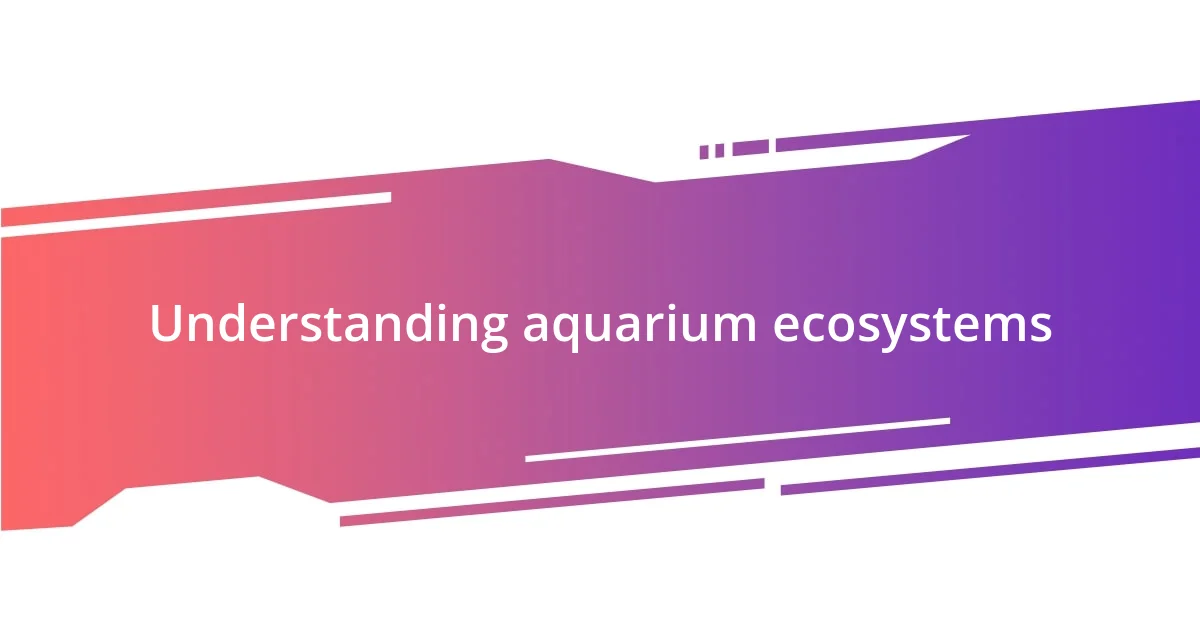
Understanding aquarium ecosystems
Aquarium ecosystems are miniature reflections of the natural world, showcasing the delicate balance between living organisms and their environment. I remember the first time I set up my own tank; the colorful fish darting about made me feel like I was peering into a vibrant underwater universe. Have you ever noticed how every element in your aquarium interacts? From the plants providing oxygen, to the beneficial bacteria breaking down waste, it’s a symbiotic relationship that mirrors the complexity of nature itself.
The layers of life within an aquarium can be truly fascinating. I once introduced a new species of shrimp and watched as they meticulously cleaned the algae off the rocks. It struck me how each creature plays a specific role, contributing to the overall health of the tank. Isn’t it amazing how even the smallest organism can have such a profound impact? This intricate dance of life in an aquarium is a reminder that every part of an ecosystem, no matter how small, is vital for harmony.
When I decided to experiment with live plants, the transformation of my tank was remarkable. Not only did the plants enhance the aesthetic appeal, but they also improved water quality, giving my fish a better environment to thrive. It made me wonder, how often do we overlook the importance of diversity in our ecosystems? This experience underscored the idea that a balanced and diverse ecosystem in an aquarium can teach us much about maintaining harmony in the broader environment around us.
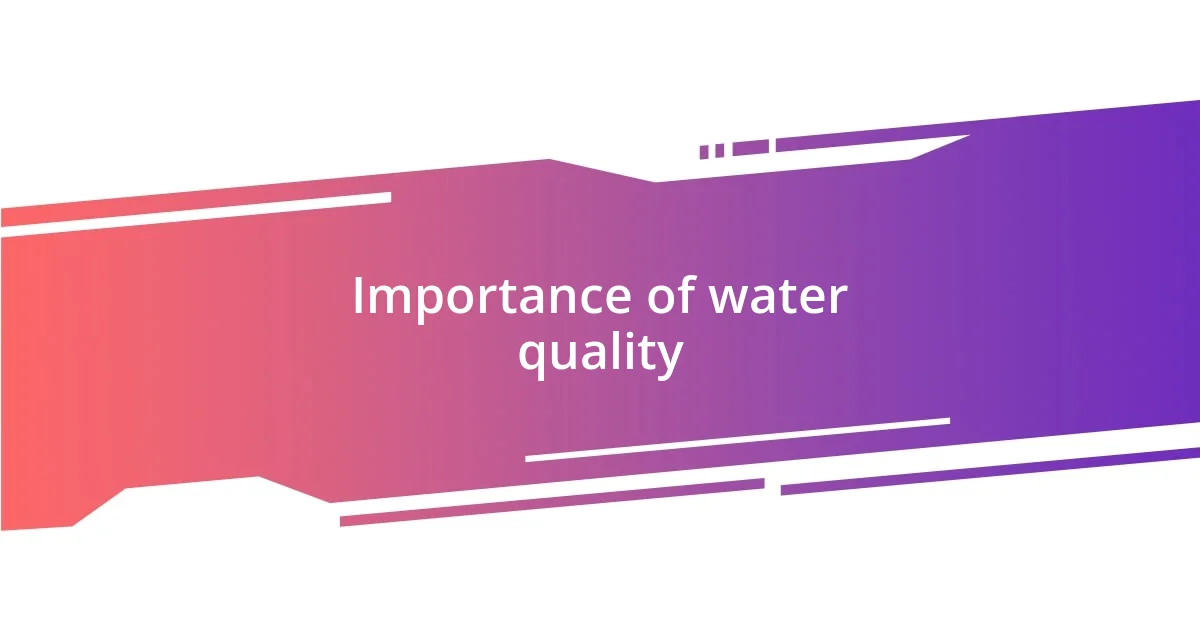
Importance of water quality
Water quality is a crucial aspect of any aquarium, profoundly affecting the health of its inhabitants. I recall a time when I neglected to monitor the nitrate levels, and the next morning, my fish were lethargic and hiding. It was a wake-up call that taught me how vital clean and balanced water is for supporting life. Without proper water quality, you risk not only the well-being of your aquatic friends but also the delicate ecosystem you’ve worked hard to create.
Here are some key factors about why water quality matters:
– pH Levels: The acidity or alkalinity can affect fish behavior and health. I learned to keep a pH test kit handy, as even small fluctuations can stress out my fish.
– Ammonia and Nitrate Levels: High levels can be toxic. I still remember how devastated I felt when I lost a fish due to my oversight of ammonia spikes.
– Temperature Stability: Fish are sensitive to temperature changes. Tracking the water temperature taught me how vital it is for their comfort and survival.
– Oxygen Levels: Dissolved oxygen is essential for fish respiration. Adding an air pump improved not just the oxygen content but also my fish’s activity levels.
Recognizing these elements has been key in my aquarium journey, reminding me that maintaining water quality is like nurturing the heartbeat of a thriving ecosystem.
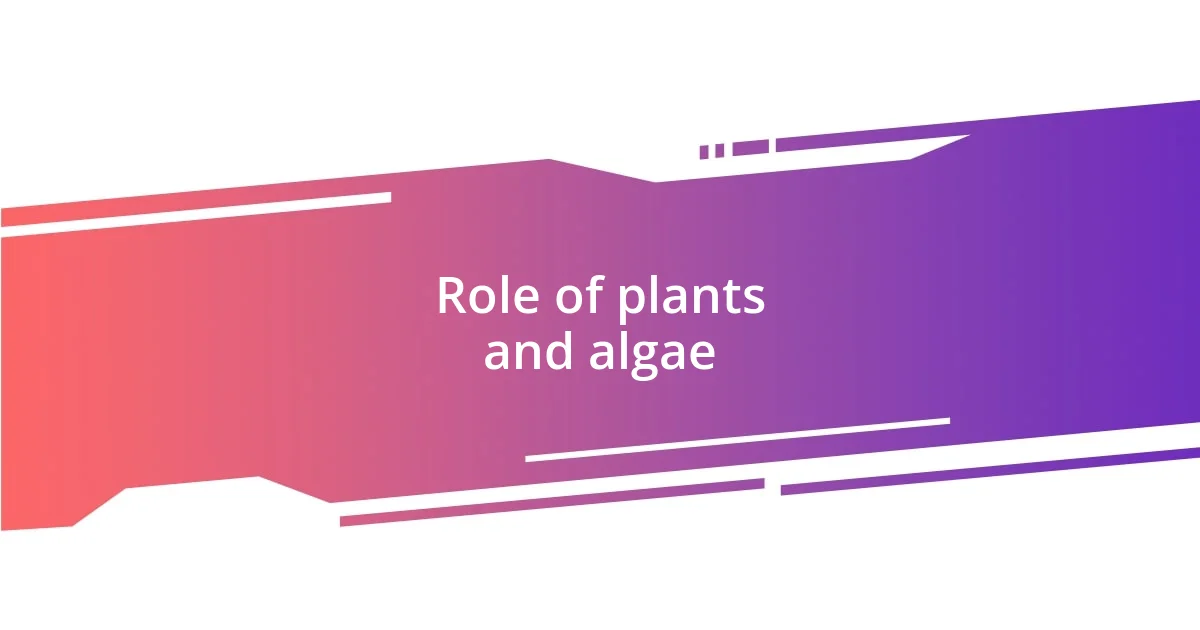
Role of plants and algae
Plants and algae serve as vital components in any aquarium ecosystem. I was astonished to see how quickly my fish thrived once I introduced a variety of aquatic plants. They not only provided hiding spots but also played a crucial role in producing oxygen through photosynthesis. This made me realize how interconnected life truly is; without these green allies, the aquatic environment would struggle to support its inhabitants.
Algae, often viewed as a nuisance, actually contributes to the ecosystem’s balance too. I learned this the hard way when I decided to minimize algae growth without understanding its role. After a few days, the tank’s bioload increased, leading to algae proliferation. This experience taught me that while I may want a crystal-clear tank, a little algae is essential in creating a stable food source for smaller fish and invertebrates. It’s fascinating how even the seemingly unappetizing aspects of nature are part of a larger cycle.
The presence of both plants and algae creates a microhabitat that encourages biodiversity. I remember my amazement watching my little guppies munching on algae while darting in and out of the lush greenery. This behavior not only supports their diet but also nurtures their instincts to forage, showcasing how these simple life forms enhance the aquarium’s dynamics. In reflecting on this, I understand now that a well-rounded ecosystem relies on every element, even those we might initially overlook.
| Component | Role in Ecosystem |
|---|---|
| Plants | Produce oxygen, provide shelter, and improve water quality. |
| Algae | Serves as a food source and aids in nutrient cycling. |
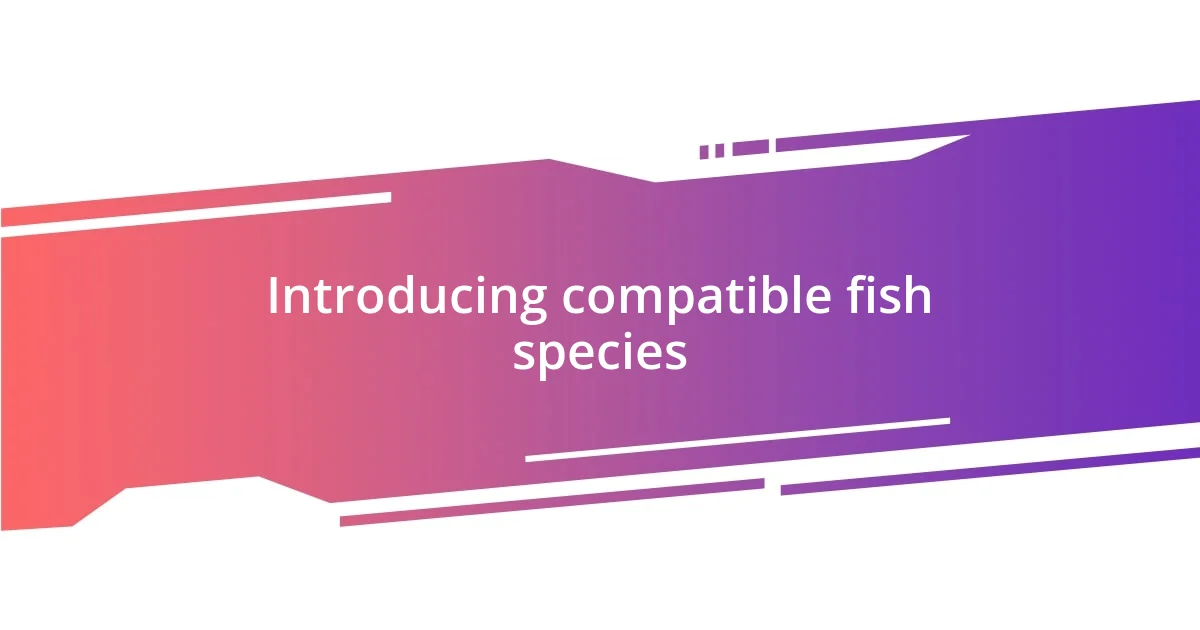
Introducing compatible fish species
When I decided to expand my aquarium, I was initially overwhelmed by the sheer number of fish species available. I quickly learned that not all fish get along, and some are downright territorial. One memorable experience was when I introduced a beautiful Betta fish, only to watch it glare at my peaceful Tetras like they were trespassers in its kingdom. This taught me the importance of researching compatible species and understanding their temperaments before making any purchases.
I found that grouping fish with similar temperaments and environmental needs not only prevents stress but adds a harmonious dynamic to the tank. For example, my calm community tank thrived when I mixed guppies and platies; their colors danced against the backdrop of green plants, creating a lively yet serene scene. Isn’t it fascinating how the right combinations can turn an aquarium into a miniature paradise, reflecting balance and harmony?
Incorporating substrate-dwelling species like Corydoras catfish also transformed my tank. These little scavengers swam tirelessly along the bottom, not just foraging for food but also helping to keep it clean. It resonated with me—creating an ecosystem requires more than just aesthetics; it involves fostering relationships among its inhabitants. Watching them interact reminded me that in nature, as in life, compatibility is key to thriving together.

Maintaining balance with filters
The journey of maintaining balance in my aquarium really opened my eyes to the essential role filters play in that ecosystem. Initially, I underestimated the importance of my filter system, thinking it was just a device to keep the water clear. However, after a week of neglecting maintenance, I watched in horror as debris and waste accumulated, clouding the water and stressing my fish. It hit me then—filters are not just about aesthetics; they are vital for ensuring a healthy environment where fish can thrive.
During one particular cleaning session, I could almost feel the relief of my fish as I replaced the filter media. The water quality instantly improved, reducing toxins like ammonia and nitrites that can quickly spiral out of control. This made me wonder: what if we viewed filters not just as machines but as the circulatory system of our tanks? It’s a realization that deepened my appreciation for the delicate balance in aquatic ecosystems.
The way a filter mimics natural processes struck a chord with me too. It provides not only mechanical filtration by removing physical debris but also biological filtration, where beneficial bacteria break down harmful substances. I remember finding it almost poetic how, through this process, my simple aquarium mirrored larger ecosystems in the wild. It made me reflect on how interconnected everything truly is, and how maintaining one element can lead to a thriving, harmonious balance in the entire system.
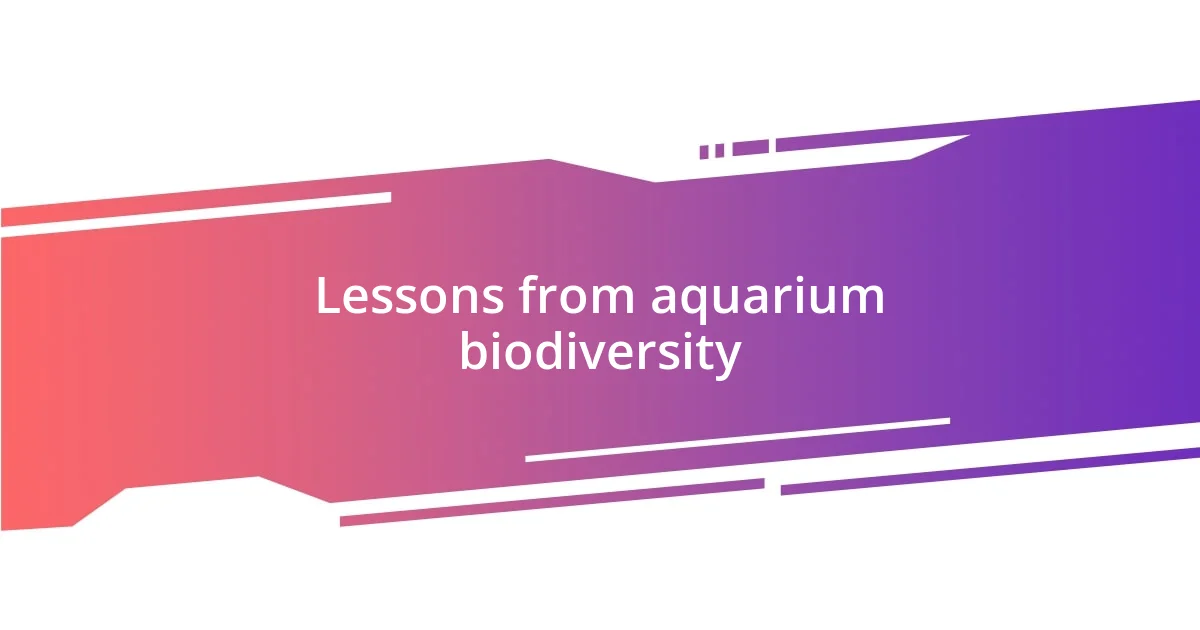
Lessons from aquarium biodiversity
The diversity in my aquarium taught me something profound about the interlinked roles of species within an ecosystem. I once added a few snails to my community tank, primarily for algae control. To my surprise, their impact rippled through the tank; the snails not only cleaned the glass and surfaces, but they also created a fascinating spectacle as they navigated their environment, promoting a sense of curiosity in me. Isn’t it intriguing how one small addition can enhance the system as a whole, showcasing nature’s intricate web of relationships?
I also encountered unexpected dynamics when I introduced a variety of plant species. Initially, I viewed them as mere decoration, but watching how the different plants interacted with the tank’s inhabitants revealed their true significance. The tall, leafy structures provided hiding spots for my shy fish, giving them a safe space to explore—or escape. This moment resonated deeply; it reminded me that every component of an ecosystem, no matter how small, has a purpose, emphasizing the rich tapestry of life we often overlook.
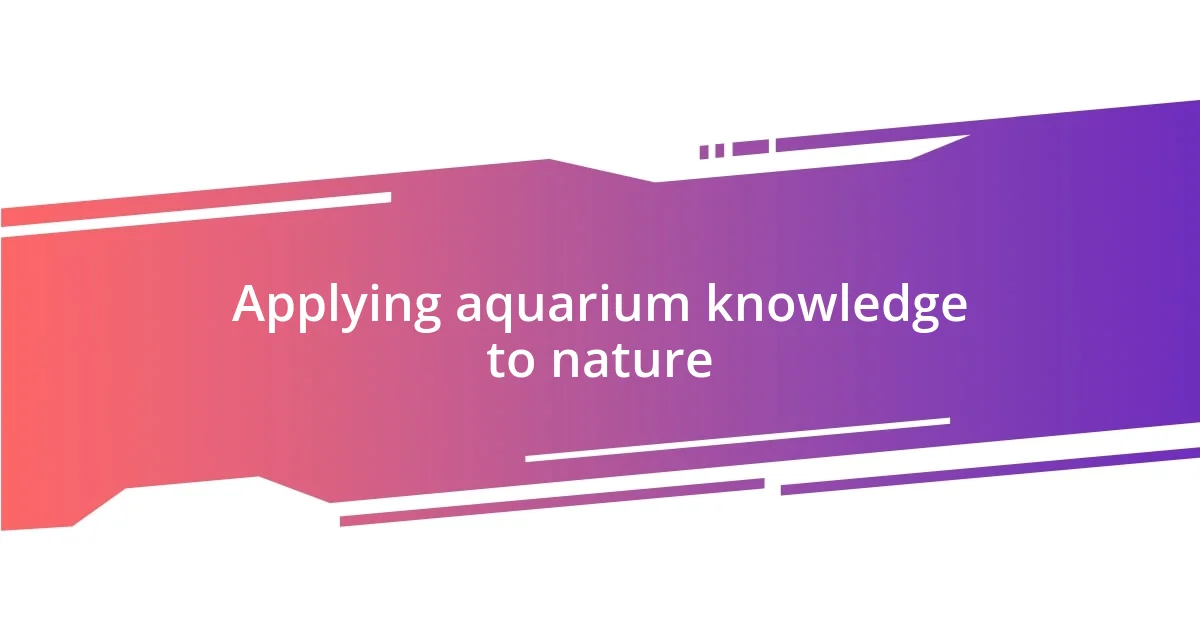
Applying aquarium knowledge to nature
I found that the principles I learned from maintaining an aquarium can apply beautifully to natural ecosystems. For instance, after a day spent cleaning my tank, I couldn’t help but draw parallels to rivers and lakes. Just like I clear out the debris and replace filter media, nature has its processes to recycle nutrients and keep environments healthy. It made me wonder about the unseen efforts of nature’s cleaners—snails, fish, and even microorganisms—working tirelessly to sustain their habitats. Have you ever considered how interconnected these roles are, both in our tanks and in widespread natural settings?
Watching the interactions among species in my aquarium pushed me to reflect on the importance of harmony in nature. Once, I noticed the chaos that unfolded when I introduced a more aggressive fish into the mix. The peace my tank once had was disrupted, leading to hidden fish and unneeded stress. That experience reminded me of how critical it is to maintain balance in ecosystems. Just like my tank, the natural world thrives when all species coexist peacefully. Can any one species really flourish alone, or do they require the support of others to truly thrive?
I learned about the effects of environmental changes firsthand when I decided to alter the lighting in my aquarium. The vibrant colors of my plants brightened, creating an inviting atmosphere. But shortly after, I noticed that the rapid growth of algae began to overtake the beauty I created. It struck me that this cycle mirrors what happens in nature—a little light can spark growth, but too much can lead to imbalance. How often do we see similar patterns in our ecosystems? My aquarium served as a microcosm, revealing the delicate dance between light and life that sustains both artificial and natural environments.















